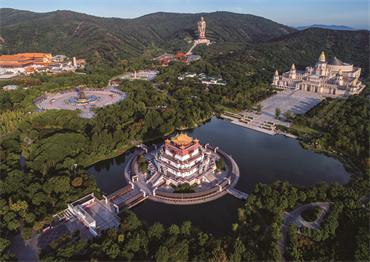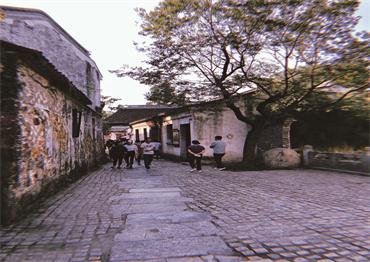The first thing that springs to most people’s minds about Wuxi is sweetness. The local cuisine is infamously heavy on the sugar, from saccharine pork buns and candy-like pork spare ribs. However, too few others know that Wuxi is a gem of a city, boasting more or less all you could want from a modern metropolis – prosperity, well-preserved nature and a long history. It’s both considered the birthplace of industrialization in China as well as having the centuries-old moniker of the “land of fish and rice.”
Located west of the Yangtze River delta in East China’s Jiangsu Province, the ancient Grand Canal flows through Wuxi, which also sits on the shores of Lake Tai – China’s third-largest freshwater lake and the source of much of the local protein.
Clues to the city’s original claim to fame can be found in its name. Wuxi literally means “without tin” – the metal that helped create the bronze age was mined in the area during the Shang Dynasty some 3,000 years ago. However, by the time of the late Han Dynasty in the second century BC, the ore had mostly been used up.
However, a mere 800 years later, Wuxi bounced back. After the Grand Canal opened in 609, the fertile and waterway-rich region became a breadbasket, giving birth to a wealthy class of traders. In the 19th century, the city’s business leaders would build a booming textile industry, sending cotton and silk products to Shanghai, from where they’d been exported to the world. Much of this industry was funded by Shanghai industrialists whose family origins lay in Wuxi. These links of commerce and blood earned the city the nickname “little Shanghai.”
A place in which you can get a sense of this late Qing prosperity is Huishan Ancient Town, located at the foot of Huishan Mountain near the city’s center. It memorializes the lifestyle of its various local literati, officials and business elites across its many ancestral temples, Jiangnan-style homes and pieces of antique furniture. Unlike many other popular “water towns” overrun by tourists and modern stores, the old architecture here is preserved and maintained well with its original aesthetic – white walls and gray tiles, with windows and doors decorated with unique carvings.
A highlight of the ancient town is Jichang Garden. Two Qing emperors visited it every time they toured their empire’s south, penning poetic tributes to its beauty along with other men of letters. A visitor can clearly see what inspired this creativity, as the garden’s sculptures and stelae mingle with twisted roots and gnarled branches.
The best way to enjoy the ancient town is by strolling on the cobbled pavement and taking the time to sit beside some lotuscovered pond, watching local children play and the grown-ups play cards or exercise. If you are hungry, you can grab some traditional snacks from nearby vendors. The most famous snack is the Huishan cake. The salty-sweet round cake – supposedly invented by monks as a gift for temple visitors – is stuffed with orange peel and walnuts. If you’re looking for a break from sweetness, you can grab a warm, tender bean curd jelly, which is served with soy sauce, chopped scallions, nori, dried shrimp, shredded pickles and sesame oil. And a little bit of sugar, obviously.
Wuxi today has grown from a regional manufacturing into a major high-tech hub, with significant chipmaking, software and medical technology industries. Since 2020, the city has actually boasted the highest GDP per capita of any city in China. But despite this, the city’s atmosphere is hardly hustle-and-bustle. Outside its laid-back urban core, scenic natural spots are just a short trip, with lakeside, riverside and mountainside views aplenty.
One of the best places to enjoy the natural side of Wuxi is the peninsula of Yuantouzhu or “turtle’s head.” Yuantouzhu, just a short way from downtown Wuxi, was dubbed as having the best views of Lake Tai by the well-known modern Chinese poet Guo Moruo. The peninsula is home to a scenic park, which is now famous for its many cherry trees, which greet spring tourists with a riot of blossoms. It’s also a great place to watch the sunset across Lake Tai. Visitors can also hop on a ferry to tiny Tai Fairy island, just a 20-minute or so ride away, which is home to its own set of temples and gardens. Beware the hungry seagulls on the boat ride.
A spot near the lake that’s well worth a trip is the Lingshan Grand Buddha, the world’s largest bronze statue of the religious teacher. The eyes of the 88-meter-tall figure seem to follow you, near or far. The statue was erected in the 1990s, but the site has a long history of Buddhist worship. It’s said that when the famous Tang dynasty monk Xuanzang visited Lingshan, he said that the mountain resembled the sacred peak in India where he had studied Buddhism. It has attracted millions of pilgrims, who besides taking in the monument can check out several other attractions. They can watch a musical fountain, with a revolving lotus flower that blooms to reveal the Buddha, who is then washed by nine rising dragons. They can also touch a nearly 12-meter-tall hand of the Buddha, to win luck and longevity.
The Lingshan scenic area also contains the Brahma Palace, which tells the story of Buddhist culture and art in China. Visitors walk through a series of vast, elaborately decorated rooms, with carved columns made of precious nanmu wood stretching upward toward pitch domes and unearthly murals. And you can also enjoy the “Ode to Auspice,” an immersive musical performance depicting the life of the Buddha, from birth to his enlightenment.
Wuxi has been well-connected for centuries, and this certainly hasn’t changed. While the Grand Canal was the highway of its day, there are now actual highways, not to mention planes and trains. Wuxi is situated on the Shanghai-Nanjing Intercity high-speed railway, linking it with Jiangsu provincial capital Nanjing, the vast Shanghai metropolis, and Suzhou, another economic center on the delta. It takes no more than 30 minutes to go to any of the places via three main train stations, namely Wuxi Railway Station, Wuxi East Railway Station and Wuxi Xinqu Railway Station. This density makes the region particularly suitable for a bit of city-hopping, and a weeklong trip could easily cover two or even three of these cities.

 Old Version
Old Version

